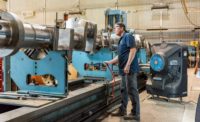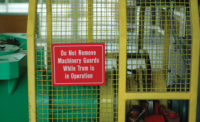According to accidents reported under RIDDOR in 2017, nine percent of fatal injuries were found to be caused by contact with moving machinery. Improving facility safety is critical to safeguard staff, but did you know safety can impact productivity and machine effectiveness too? Here, Jonathan Wilkins, marketing director at obsolete equipment supplier EU Automation, shares his three tips for machine safety.
Machine safety is of the utmost importance to manufacturers to reduce the risk of accidents and safeguard staff. However, the benefits of a comprehensive safety strategy can extend far beyond this.
Consider
When installing a new machine, the plant manager must carefully consider how it fits into the manufacturing facility as a whole to develop safe and ergonomic working practices. The plant manager should conduct risk assessments to ensure that the environment is safe, considering factors such as machine emissions, which may impact the ventilation needed in a facility.
Each type of equipment will have different safety considerations. For example, electrical equipment will likely be covered by EN 60204-1, which specifies requirements for enclosures, isolators, actuators and documentation.
Manufacturers must ensure their equipment has been manufactured according to the relevant standards – but also that they operate to them. Some equipment may have to comply with the ATEX 137 Directive or the Dangerous Substances and Explosive Atmospheres Regulations (DSEAR), if there is a risk of explosion. Compliance with these regulations is crucial in safeguarding your production facility, and, more importantly, your staff.
Communicate
Without a full understanding of how to operate machinery, staff could be at risk of injury. Performing detailed training to help your staff get to grips with the correct processes and procedures for machine operation is essential in managing safety. This should also cover the required personal protective equipment (PPE) that is to be worn during operation.
Staff can be provided with checklists to help ensure operation and maintenance is performed correctly. There should also be a central person, such as a safety manager, that your staff can contact in case of confusion or query. This will help remove the risk of human error.
Connect
Adding sensors to the production line to monitor the performance of your equipment can improve workplace safety. By making the best use of Internet of Things (IoT) technology, plant managers can gather and analyze real-time information on the performance of their equipment and staff. This can help reduce common accidents and help identify any issues with machinery, which may also be a safety risk to staff.
The connected equipment can measure machine parameters to warn of any risk of overheating, which can be a factor in breakdown. If a serious risk is detected, staff can be evacuated. However, if it is simply a broken part, the connected system can warn the plant manager to order a replacement component, perform maintenance and get the system back to running optimally.
Workplace safety is critical to reduce the risk of fatal and non-fatal accidents. The benefit it offers to workers is a fundamental priority, but connecting systems to improve safety, productivity and performance is a much-welcomed bonus.
Jonathan Wilkins, EU Automation
Unit 3, Parker Court, Staffordshire Technology Park, Stafford, ST18 0WP
Telephone: +44 (0) 845 521 3088
www: http://www.euautomation.com
e-mail: jonathan.wilkins@euautomation.com
Twitter: http://twitter.com/euautomation
About EU Automation: EU Automation stocks and sells new, used, refurbished and obsolete industrial automation spares. Its global network of preferred partner warehouses, and wholly owned distribution centers, enables it to offer a unique service within the automation industry, spanning the entire globe. It provides worldwide express delivery on all products meaning it can supply any part, to any destination, at very short notice.



